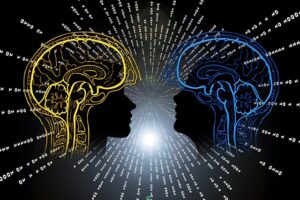It’s long been believed that advancing age leads to broad declines in our mental abilities. Now new research from Georgetown University Medical Center offers surprisingly good news by countering this view.
 The findings, published August 19, 2021, in Nature Human Behaviour, show that two key brain functions, which allow us to attend to new information and to focus on what’s important in a given situation, can in fact improve in older individuals. These functions underlie critical aspects of cognition such as memory, decision making, and self-control, and even navigation, math, language, and reading.
The findings, published August 19, 2021, in Nature Human Behaviour, show that two key brain functions, which allow us to attend to new information and to focus on what’s important in a given situation, can in fact improve in older individuals. These functions underlie critical aspects of cognition such as memory, decision making, and self-control, and even navigation, math, language, and reading.
“These results are amazing, and have important consequences for how we should view aging,” says the study’s senior investigator, Michael T. Ullman, PhD, a professor in the Department of Neuroscience, and Director of Georgetown’s Brain and Language Lab.
“People have widely assumed that attention and executive functions decline with age, despite intriguing hints from some smaller-scale studies that raised questions about these assumptions,” he says. “But the results from our large study indicate that critical elements of these abilities actually improve during aging, likely because we simply practice these skills throughout our life.”
“This is all the more important because of the rapidly aging population, both in the US and around the world,” Ullman says. He adds that with further research, it may be possible to deliberately improve these skills as protection against brain decline in healthy aging and disorders.
The research team, which includes first author João Veríssimo, PhD, an assistant professor at the University of Lisbon, Portugal, looked at three separate components of attention and executive function in a group of 702 participants aged 58 to 98. They focused on these ages since this is when cognition often changes the most during aging.
The components they studied are the brain networks involved in alerting, orienting, and executive inhibition. Each has different characteristics and relies on different brain areas and different neurochemicals and genes. Therefore, Ullman and Veríssimo reasoned, the networks may also show different aging patterns.
Alerting is characterized by a state of enhanced vigilance and preparedness in order to respond to incoming information. Orienting involves shifting brain resources to a particular location in space. The executive network inhibits distracting or conflicting information, allowing us to focus on what’s important.
“We use all three processes constantly,” Veríssimo explains. “For example, when you are driving a car, alerting is your increased preparedness when you approach an intersection. Orienting occurs when you shift your attention to an unexpected movement, such as a pedestrian. And executive function allows you to inhibit distractions such as birds or billboards so you can stay focused on driving.”
The study found that only alerting abilities declined with age. In contrast, both orienting and executive inhibition actually improved.
The researchers hypothesize that because orienting and inhibition are simply skills that allow people to selectively attend to objects, these skills can improve with lifelong practice. The gains from this practice can be large enough to outweigh the underlying neural declines, Ullman and Veríssimo suggest. In contrast, they believe that alerting declines because this basic state of vigilance and preparedness cannot improve with practice.
“Because of the relatively large number of participants, and because we ruled out numerous alternative explanations, the findings should be reliable and so may apply quite broadly,” Veríssimo says. Moreover, he explains that “because orienting and inhibitory skills underlie numerous behaviors, the results have wide-ranging implications.”
“The findings not only change our view of how aging affects the mind, but may also lead to clinical improvements, including for patients with aging disorders such as Alzheimer’s disease,” says Ullman.
###
Ullman and Veríssimo report having no personal financial interests related to the study.
In addition to Ullman and Veríssimo, the authors include Paul Verhaeghen, Georgia Institute of Technology; Noreen Goldman, Princeton University; and Maxine Weinstein, Georgetown University.
This work was supported by the National Institutes of Health (R01 AG016790, R01 AG016661); the National Science Foundation (BCS 1940980); the Deutsche Forschungsgemeinschaft; and the Georgetown Graduate School of Arts and Sciences.
About Georgetown University Medical Center
As a top academic health and science center, Georgetown University Medical Center provides, in a synergistic fashion, excellence in education — training physicians, nurses and other health care professionals, as well as biomedical scientists — and cutting-edge interdisciplinary research collaboration, enhancing our basic science and translational biomedical research capacity in order to improve human health. Patient care and clinical research is conducted with our clinical partner, MedStar Health. GUMC’s mission is carried out with a strong emphasis on social justice and a dedication to the Catholic, Jesuit principle of cura personalis — or “care of the whole person.” GUMC comprises the School of Medicine, the School of Nursing & Health Studies, Biomedical Graduate Education, and Georgetown Lombardi Comprehensive Cancer Center. Designated by the Carnegie Foundation as a „very high research activity university,” Georgetown is home to a Clinical and Translational Science Award from the National Institutes of Health, and a Comprehensive Cancer Center designation from the National Cancer Institute.